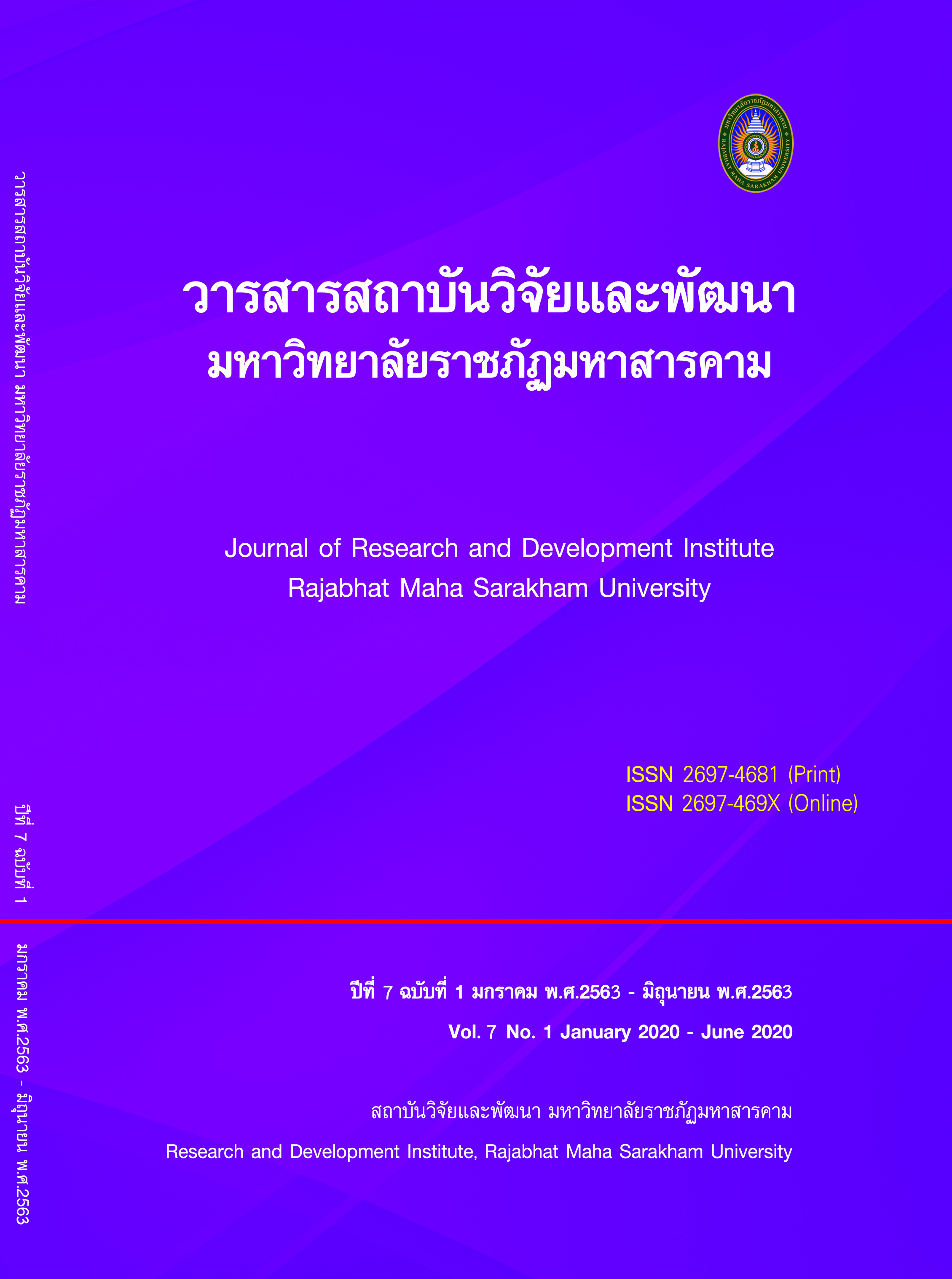รูปแบบการพัฒนาประสิทธิผลองค์การของโรงเรียนประถมศึกษาขนาดเล็ก สังกัดสำนักงานคณะกรรมการการศึกษาขั้นพื้นฐานในภาคการศึกษาที่ 11
คำสำคัญ:
รูปแบบการพัฒนา, ประสิทธิผลองค์การ, โรงเรียนประถมศึกษาขนาดเล็กบทคัดย่อ
การวิจัยครั้งนี้มีวัตถุประสงค์เพื่อ ศึกษาความสอดคล้องกลมกลืนของรูปแบบปัจจัยที่มีอิทธิพลต่อประสิทธิผลองค์การของโรงเรียนประถมศึกษาขนาดเล็ก กลุ่มเป้าหมาย จำนวน 10 คน ได้แก่ ที่เกี่ยวข้อง และการถอดบทเรียนโรงเรียนต้นแบบด้านประสิทธิผลหรือโรงเรียนที่มีผลการประเมินการประกันคุณภาพภายในระดับดีมาก เลือกแบบเจาะจง เครื่องมือที่ใช้ในการวิจัย ได้แก่ แบบสัมภาษณ์กึ่งมีโครงสร้างและแบบสอบถามชนิดมาตราส่วนประมาณค่า สถิติที่ใช้ในการวิเคราะห์ข้อมูล ได้แก่ ค่าเฉลี่ย ส่วนเบี่ยงเบนมาตรฐานและการวิเคราะห์เชิงเนื้อหา ผลการวิจัยพบว่า ด้านภาวะผู้นำเชิงสร้างสรรค์ พบว่า โดยรวมอยู่ในระดับมากที่สุด ( = 4.55) เมื่อพิจารณาเป็นรายด้านเรียงจากค่าเฉลี่ยมากไปหาน้อย ดังนี้ ด้านความยืดหยุ่น ( = 4.63) ด้านวิสัยทัศน์ ( = 4.58) ด้านบุคลากรโรงเรียน ( = 4.51) และด้านจินตนาการ ( = 4.49) ด้านวัฒนธรรมองค์การพบว่า โดยรวมอยู่ในระดับมากที่สุด ( = 4.54) เมื่อพิจารณาเป็นรายด้านเรียงจากค่าเฉลี่ยมากไปหาน้อย ดังนี้ ด้านความเชื่อ ( = 4.59) ด้านค่านิยม ( = 4.52) ด้านขนบธรรมเนียม ( = 4.53) ด้านบรรทัดฐาน (= 4.54) และด้านองค์การ (= 4.52) ด้านธรรมาภิบาล พบว่า โดยรวมอยู่ในระดับมากที่สุด ( = 4.53) เมื่อพิจารณาเป็นรายด้านเรียงจากค่าเฉลี่ยมากไปหาน้อย ดังนี้ ด้านคุณธรรม (= 4.57) ด้านนิติธรรม (= 4.54) ด้านความเสมอภาค (= 4.54) ด้านความรับผิดชอบ (= 4.52) ด้านความโปร่งใส (= 4.52) และด้านการมีส่วนร่วม (= 4.51) ด้านประสิทธิผลองค์การ พบว่า โดยรว (= 4.42) อยู่ในระดับมากที่สุด ( = 4.42) เมื่อพิจารณาเป็นรายด้านเรียงจากค่าเฉลี่ยมากไปหาน้อย ดังนี้ กลุ่มตัวบ่งชี้พื้นฐาน ( = 4.48) กลุ่มตัวบ่งชี้มาตรการส่งเสริม ( = 4.41) และกลุ่มตัวบ่งชี้อัตลักษณ์ ( = 4.37)
เอกสารอ้างอิง
References
Benjawan Wandeesri. (2007). A study of Good Gvernance of the Chairman of the Locality Administrative Organization in Roi Et. Master of Arts Thesis (Social Sciences for Education): Thonburi Rajabhat University.
Bennis, W. (2002). Creative Leadership. [ABI]. Bangkok: Chulalongkorn University
Cameron, K. S., & Quinn, R. E. (2011). Diagnosing and Changing Organizational Culture: Based on the Competing Values Framework. 3rd edition. San Francisco: Jossey-Bass.
Certo, S.C.,& Peter, J.P. (1991). Strategic Management: Concept and Applications. New York: MacGraw – Hill.
Chernin, P. (2001). “Creative leadership: The strength of ideas The power of the imagination.” Vital Speeches of the Day, 68 (8), 245.
Couto, R. A., & Eken, S. C. (2002). To give their gifts: Health, community, and democracy. Nashville: Vanderbilt University Press.
Cummings, T. G., & Worley, C. G. (2005). Organization Development and Change. 8th edition. Ohio: Thomson South-Western.
Danner, S. E. (2008). Creative Leadership in Art Education: Perspectives of an Art. Educator. Doctor's Thesis, Ohio: Art Education (Fine Arts), Ohio.
DuBrin, A. J. (2013). Principles of leadership. 7th edition. Australia: South-Western, Cengage Learning.
Harris, A. (2009). “Creative Leadership”. Journal of Management in Education, 23 (1): 9 - 11.
Hendrik, Joost Tennekes. (2005). Donors and Good Governance: Analysis of a Policy Discourse in the Netherlands and Germany. PhD. Dissertation. Enschede, Netherlands : University of Twente.
Juthaphon (Chamchuri) Phadungchiwit. (2008). Culture, Communicat and Identity. Bangkok: Chulalongkorn University Press,
King Prajadhipok’s Institute. (2006). Tentham: Indicators for good corporate governance. Bangkok: King Prajadhipok's Institute.
KITTKHAN PATIPAN. (2012). A STRUCTURAL EQUATION MODEL OF CREATIVE LEADERSHIP FOR VOCATIONAL COLLEGE ADMINISTRATORS. Thesis on Philosophy of Philosophy of Bhandit (Educational Administration): Khon Kaen University.
Krejcie, R. V. & Morgan, D. W. (1970). “Determining Sample Size for Research Activities”. Educational and Psychological Measurement, 30 (3), pp. 607-610.
Luecke, Richard; Ralph Katz. (2003). Managing Creativity and Innovation. Boston. MA: Harvard Business School Press.
Ministry of Education. (2003). National Education Act, B.E. 2542, Amendment (No. 2), B.E. 2545. Bangkok: Teachers Council.
Ministry of Education. (2013). Instructor training manual, paradigm adjustment and educational institution curriculum development.. Bangkok : Teachers Council.
Nared Boonchuay et al. (2010). STRATEGIC PLAN FOR DEVELOPING CREATIVE LEADERSHIP SUITABLE FOR SCHOOL ADMINISTRATORS. Doctor of Education Thesis (Educational Administration): Valaya Alongkorn Rajabhat University under Royal Patronage.
Natthaphan Kecharananta. (2008). Organizational behavior. Bangkok: Se-Education.
Natthida Chujaroenpipat. (2012). Organizational culture affecting employees' work performance of siam commercial bank in Nakorn Sawan. Master of Business Administration (General Administration): Rajamangala University of Technology Thanyaburi.
Office of the Public Sector Development Commission. (2009). Handbook for grading of public organization governance according to the principles of good governance). Bangkok: Premier Pro.
Palus, C. J., & Horth, D. M. (2005). The leader’s edge: Six creative competencies for navigating complex challenges. San Francisco: Jossey Bass.
Parker, J. P., & Begnaud, L. G. (2004). Developing creative leadership. Portsmouth, NH: Teacher Ideas Press.
Philip Kotler. (2005). Marketing Management. 12th edition. New Jersey: Prentice-Hall.
Rangsan Prasertsri. (2008). Leadership. 2nd edition, Bangkok: Thira Film and Citex.
Robbin, S.P., & Coulter, M. (1999). Management. 6th edition. New Jersey: Prentice-Hall.
Royal Decree on Rules and Procedures for Good Corporate Governance, 2003
Schein, E. H. (1983). “The role of the founder in creating organizational culture”. Organizational Dynamics, 12 (1), 13–28.
Schein, E. H. (1996). “Culture: The missing concept in organization studies”. Administrative Science Quarterly, 41 (2), 229–240.
Schermerhorn. J. R. (1999). Management. 5th edition. USA: John Wiley and Sons.
Sergiovanni, T. J. and Starratt,R. J. (1988). Supervision: Human Perspectives. New York: McGraw-Hill.
Sirikorn Suksudpaisarn and Karnravee Anuntaakalakul. (2013). “Organizational Culture and Motivation Influencing Working Effeciency of Civil Servant in Bangkok Metropolitan”. Srinakharinwirot Business Journal, 4 (2),41-54.
Sumet Saengnimnuan. (2009). Leadership and good governance in the administration of local government organizations. Nonthaburi : King Prajadhipok’s Institute,
Sutham Songsiri. (2010). Good governance. [Online] http://th.wikipedia.org [30 August 2017]
Thara Ruharoj, Aek Sichaliang and Chanchai Chitlaoarporn. (2013). “THE APPLICATION OF GOOD GOVERNANCE PRINCIPLES FOR THE ADMINISTRATIONS OF WANGCHULA SUB DISTRICT ADMINISTRATIVE ORGANIZATION IN WANG NOI DISTRICT, PHRA NAKHON SI AYUTTHAYA PROVINCE”. Valaya Alongkorn Review, 3 (1), 59-71.
Ubben, G. C., Hughes, L. W., & Norris, C. J. (2001). The principal: creative leadership for effective School. Boston: Allyn & Bacon.
Waro Phengsawat. (2010). Applied Statistics for Social Science Research. Bangkok: Suwirisan.
Watcharee Sriwichai. (2010). Good governance of Tambon Municipalities in Ko Kha District, Lampang Province. Chiang Mai: Chiang Mai University.
Wichian Vitayaudom. (2009). Human resource management. 2nd edition. Bangkok: Thanatat Publication.
Wimol Jankaew. (2012). A CREATIVE LEADERSHIP DEVELOPMENT MODEL FOR THE SCHOOL DIRECTORS OF SURATTHANI PRIMARY EDUCATION SERVICE AREA OFFICE 3. Doctor of Education Dissertation (Education): Graduate School, Rangsit University.
Wirayut Phonphotthanamat . (2014). “Components of good governance in schools”. Executive Journal, 34 (1), 79-88.
World Bank. (2001). Poverty and Income Distribution in a High Growth Economy: The Case of Chile 1987-98. Washington D.C., U.S.A.
ดาวน์โหลด
เผยแพร่แล้ว
รูปแบบการอ้างอิง
ฉบับ
ประเภทบทความ
สัญญาอนุญาต
บทความที่ได้รับการตีพิมพ์เป็นลิขสิทธิ์เป็นของผู้ประพันธ์บทความ







